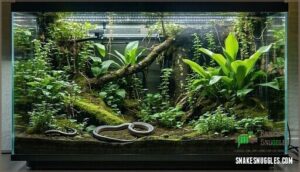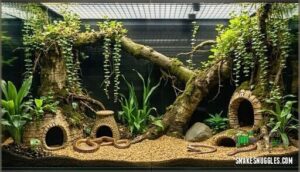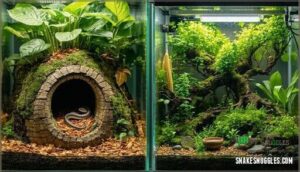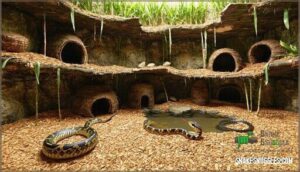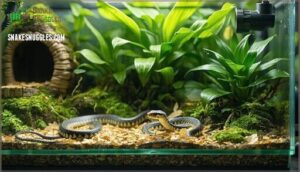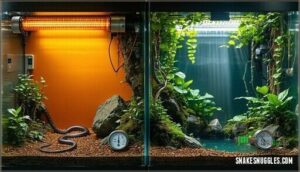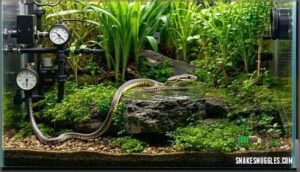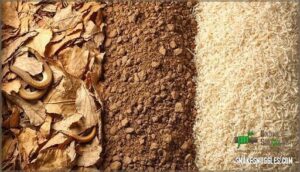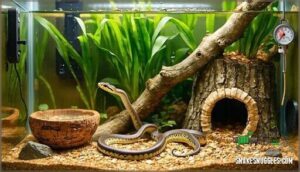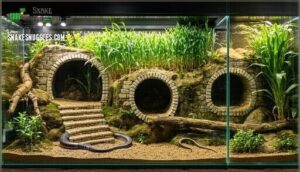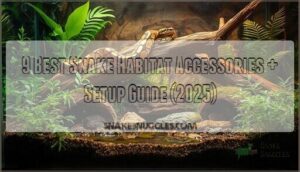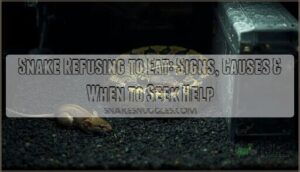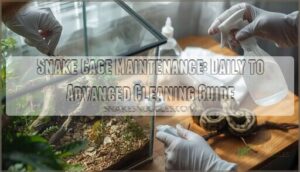This site is supported by our readers. We may earn a commission, at no cost to you, if you purchase through links.
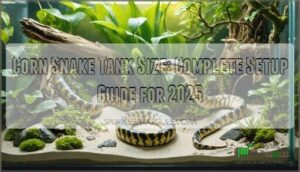 A corn snake can stretch farther than your outstretched arm, yet squeeze through gaps you wouldn’t believe. Tucking one into a too-small tank isn’t just uncomfortable—it can mess with their health and stress them out. You want a confident, curious snake, not one hiding all day or refusing to eat.
A corn snake can stretch farther than your outstretched arm, yet squeeze through gaps you wouldn’t believe. Tucking one into a too-small tank isn’t just uncomfortable—it can mess with their health and stress them out. You want a confident, curious snake, not one hiding all day or refusing to eat.
Getting corn snake tank size right is about so much more than just measurements; it means giving your snake space to climb, curl up, and show off those natural instincts. Understanding what these snakes really need changes everything about how you set up their home.
Table Of Contents
- Key Takeaways
- Choosing The Right Size Enclosure
- Recommended Enclosure Size for Corn Snakes
- Enclosure Dimensions for Climbing and Hiding
- Temperature Requirements for Corn Snakes
- Creating a Thermal Gradient in The Enclosure
- Humidity and Lighting for Corn Snakes
- Bedding and Substrate Options for Corn Snakes
- Accessories for a Corn Snake Enclosure
- Setting Up a Safe and Secure Enclosure
- Frequently Asked Questions (FAQs)
- How big of a tank does my corn snake need?
- Is a 20 gallon tank enough for a corn snake?
- Can a corn snake live in a 40 gallon tank?
- Can a corn snake live in a 25 gallon tank?
- How frequently should you clean a corn snake tank?
- What type of heating is safe for corn snakes?
- Can corn snakes be housed with other pets?
- How do you prevent a corn snake escape?
- What is the optimal diet for corn snakes?
- How often should the tank size be upgraded?
- Conclusion
Key Takeaways
- Your corn snake needs at least 48"L x 24"W x 24"H floor space (roughly a 75-gallon tank) as an adult, calculated using 0.7 times length by 0.5 times length to allow proper stretching, climbing, and thermoregulation without causing stress or health issues.
- A proper thermal gradient between 75-85°F with multiple heat sources (heat lamp and under-tank heater controlled by thermostats) lets your snake regulate body temperature naturally, while avoiding dangerous hot rocks that cause severe burns.
- Vertical space matters just as much as floor space—your corn snake needs climbing structures like branches and multiple hiding spots positioned in both warm and cool zones to express natural behaviors and reduce stress.
- Plan your enclosure based on adult size (3-5 feet) from the start rather than upgrading repeatedly, and maintain proper humidity (40-60%, raised to 70% during shedding) with regular spot cleaning and monthly full disinfection to prevent health problems.
Choosing The Right Size Enclosure
Picking the right enclosure size isn’t guesswork—it’s based on your snake’s length and natural behaviors. The size you choose affects everything from thermoregulation to stress levels, so getting it right from the start matters.
Here’s how to calculate the minimum dimensions and decide what works best for your corn snake.
Minimum Floor Dimensions for Corn Snakes
Think of your corn snake’s floor space like a studio apartment—it needs enough room to stretch out corner to corner without feeling cramped.
Here’s what you need to know about minimum corn snake enclosure size:
- Length vs. width: Your enclosure dimensions should equal your snake’s length when added together
- Formula accuracy: Calculate using (0.7 × snake length) by (0.5 × snake length) for minimum floor space
- Growth considerations: Base tank size guidelines on adult length, not current size
This approach gives your snake proper enclosure size for natural movement.
Calculating The Ideal Enclosure Size
Let’s run the numbers using the Swiss formula for determining corn snake terrarium size. Multiply your adult snake length by 0.7 for enclosure length, then by 0.5 for width. A 4-foot corn snake needs 2.8 feet by 2 feet of floor space—that’s 5.6 square feet total. Add a minimum height of 24 inches for climbing.
For gallon conversion, this translates to roughly a 40-gallon tank, though dimensions matter more than volume when matching tank size guidelines to snake growth patterns. A larger enclosure is beneficial, as it promotes better overall health.
Considering The Snake’s Current and Adult Size
Your snake won’t stay the size it’s now, so planning for its full adult length—anywhere from 3 to 5 feet—saves you from buying multiple tanks down the road. Ask the breeder about parent sizes to predict adult corn snake enclosure needs:
- Males usually match their father’s length
- Females mirror their mother’s size
- Growth rate factors vary by genetics and feeding
Gender size differences matter when predicting snake size. Don’t overestimate—hatchling enclosure size doesn’t need upgrading immediately if you start with adult dimensions.
Recommended Enclosure Size for Corn Snakes
Now that you understand the basic math behind terrarium sizing, let’s look at specific enclosure recommendations.
The following options balance minimum requirements with practical setup considerations.
Each size covers different stages of your corn snake’s life and varying space constraints.
Absolute Minimum Recommended Enclosure Size
A cramped cage isn’t just uncomfortable—it can directly harm your snake’s ability to regulate body temperature and express natural behaviors. For responsible care, never go below 48"L x 24"W x 24"H (120 x 60 x 60cm). This minimum tank size enables proper thermoregulation and reduces snake stress while meeting basic corn snake enclosure requirements.
| Space Constraints | Growth Impact | Ethical Considerations |
|---|---|---|
| Limits movement patterns | Stunted physical development | Compromises welfare standards |
| Blocks thermal gradient | Restricted muscle tone | Ignores natural behavior needs |
| Prevents climbing behavior | Inadequate exercise | Creates unnecessary suffering |
| Reduces enrichment options | Poor body condition | Violates humane care principles |
| Increases territorial stress | Long-term health issues |
Benefits of Larger Enclosures
When you provide more space, you’re not just being generous—you’re directly supporting your snake’s physical and mental health. Enclosure size plays a key role in snake wellbeing, allowing for activity levels that keep muscles strong and minds engaged. Larger setups enable environmental enrichment through climbing branches and multiple hides, which stabilizes temperature zones and encourages natural behaviors like exploring and thermoregulating. A 40-gallon tank is generally accepted as adequate tank size for adult corn snakes.
Why bigger tanks matter:
- Enhanced activity levels – Your snake moves more freely, improving muscle tone and reducing obesity risks
- Better psychological well-being – Extra room decreases stress-related behaviors like repetitive pacing or excessive hiding
- Stable environmental conditions – Larger air volumes maintain consistent temperature stability and humidity, preventing health issues like respiratory problems or retained sheds
Enclosure Size for Babies and Yearlings
Most baby corn snakes start life in surprisingly modest quarters—think 10 gallons or less—but that doesn’t mean cramped is better. Your hatchling needs secure hiding spots more than square footage.
As juvenile growth rates kick in—often doubling length within months—plan gradual upsizing of tanks every six to twelve months. A baby corn snake enclosure around 10-20 gallons works initially, then shift juvenile corn snakes to 30+ gallons by the yearling stage, matching feeding impact size and natural development.
Enclosure Dimensions for Climbing and Hiding
Your corn snake needs more than just floor space—it needs vertical room to climb and secure spots to hide. Both climbing and hiding are essential behaviors that directly impact your snake’s stress levels and overall health.
Let’s look at the specific dimensions that support these natural instincts.
Providing Adequate Climbing Space
Your corn snake needs vertical space to thrive. Aim for a minimum enclosure height of 24 inches to support natural climbing behavior.
Install sturdy climbing structures like grapevine or driftwood with branch diameters between 1-2 inches—thick enough for a secure grip. Anchor materials firmly using wire or silicone for fall prevention, and arrange vertical climbing routes at different levels to promote behavioral diversity.
This environmental enrichment reduces stress through elevated security while mimicking the snake’s instinct to explore upward, just like they would in rocky woodland habitats.
Importance of Hiding Spots
Think of your corn snake as a naturally cautious animal—without proper hiding spots, it’s like living in a glass house where every shadow feels like a threat. Providing multiple hides lessens stress and encourages natural behavior essential for snake wellbeing.
Place at least two hides in your snake enclosure—one on the warm side and one on the cool side:
- Snug-fitting shelters that allow your snake to feel walls on all sides for security needs
- Opaque materials like cork bark, half-logs, or commercial reptile hides for effective hiding benefits
- Multiple hiding options throughout the habitat to encourage natural exploration and enrichment value
- Easy-access placement near temperature zones so your snake can thermoregulate without exposure
- Varied hide styles including ground-level caves and elevated platforms for behavioral diversity
This setup lessens stress while promoting healthy reptile care practices.
Recommended Enclosure Height
While most reptile keepers focus on floor space, height matters just as much—your corn snake isn’t content staying grounded when branches and vertical exploration call. Aim for at least 24 inches of height to support arboreal behavior and climbing opportunities. This vertical enrichment allows your snake to utilize space efficiently while engaging in natural corn snake climbing behavior.
Add climbing materials like cork branches or sturdy vines throughout the enclosure—your snake will weave between them naturally, promoting both physical health and mental stimulation.
| Enclosure Feature | Height Benefits |
|---|---|
| Climbing structures (branches, vines) | Encourages environmental enrichment and exercise |
| Elevated platforms | Provides multiple temperature zones for thermoregulation |
| Vertical space utilization | Reduces stress through increased territory and exploration options |
Temperature Requirements for Corn Snakes
Getting the temperature right isn’t just about keeping your corn snake alive—it’s about keeping them healthy and comfortable. Your snake needs specific temperature zones to digest food, stay active, and thrive.
Let’s break down exactly what temperatures you need to maintain and how to create them properly.
Hot and Cool Side Temperatures
Your corn snake’s tank size matters for thermoregulation, but temperature gradient is just as vital for snake health. Set your warm side between 80-85°F and your cool side at 75-82°F—this gradient importance can’t be overstated. Use digital probe thermometers for measuring temperatures accurately, checking both hides and air temps to avoid extremes that stress your snake.
- Hatchling temperatures need careful monitoring since juveniles are more sensitive
- Night temperatures can drop to 75°F for adults without harm
- Corn snake health depends on consistent thermal zones, not guesswork
Basking and Nighttime Temperatures
Beyond setting the right gradient, you need to nail your basking spot—think of it as your snake’s personal sunbathing deck where they can soak up heat on demand. Aim for a basking area of 85-88°F using heat lamps or another heat source controlled by a thermostat.
Your snake’s basking duration varies based on their thermoregulation needs. At night, temperature drops to 72-75°F are natural and healthy—no need for nighttime heating in most homes.
Heating Elements for Corn Snakes
Now that you’ve dialed in those temperatures, let’s talk about the actual equipment you’ll use to create that perfect warmth.
Your heat source options include:
- Ceramic heat emitters: Produce infrared heat without light, ideal for maintaining your temperature gradient around the clock with proper thermostat control
- Heat lamps with basking bulb options: Create focused warmth and encourage natural behaviors when positioned over a basking rock
- Heat mat safety: Under-tank heaters work well but require temperature probes and thermostats to prevent burns
- Thermostat control: Non-negotiable for any heat source—it’s your safety net against overheating disasters
Creating a Thermal Gradient in The Enclosure
A proper thermal gradient lets your corn snake move between warm and cool zones to regulate its body temperature naturally. You’ll need the right heating tools and reliable monitoring to create this gradient safely.
Let’s look at the key methods and practices that make this setup work.
Using a Heat Lamp and Under Tank Heater
To build a thermal gradient that actually works, you’ll need to combine two heat sources—a heat lamp positioned over one end of the enclosure and an under-tank heater placed beneath the opposite side. This setup gives your snake the temperature gradient it needs for proper thermoregulation. The heat lamp creates your warm basking zone, while the UTH placement maintains belly heat for digestion. Always use thermostat control with both heat sources to prevent overheating and improve energy efficiency.
| Heat Source | Purpose |
|---|---|
| Heat lamp | Creates basking spot (85-90°F) |
| Under-tank heater (UTH) | Provides gentle belly warmth |
| Thermostat | Prevents dangerous temperature spikes |
| Thermometer | Confirms accurate heat distribution |
Heat lamp safety matters—keep fixtures secure and away from direct snake contact to avoid burns.
Monitoring Terrarium Temperatures
Once you’ve got your heat sources in place, checking the actual temperatures inside the tank becomes your daily routine. Use digital thermometers with temperature probes on both the warm and cool ends to get accurate readings. An infrared thermometer helps you spot-check surface temps quickly.
Consistent monitoring makes certain your snake can thermoregulate properly across the thermal gradient. Pair your thermometer with a hygrometer to track humidity, and always verify your thermostat calibration periodically to maintain reliable heating and lighting conditions.
Avoiding Hot Rocks
Hot rocks might seem like an easy heating solution, but they’re actually one of the biggest hazards you can introduce to your corn snake’s enclosure. These devices create uneven heat that causes severe burn risks because your snake can’t sense the danger until it’s too late.
For proper thermoregulation and reptile welfare, stick to safer alternatives like overhead heat lamps or under-tank heaters with thermostats—they maintain your thermal gradient without compromising snake safety.
Humidity and Lighting for Corn Snakes
Corn snakes don’t need extreme humidity, but you’ll want to keep the air in their enclosure at the right level to support healthy shedding.
Proper lighting also plays a bigger role than many keepers realize, especially if you want your snake to thrive long-term. Let’s look at how to manage both humidity and light in your setup.
Maintaining Proper Humidity Levels
Maintaining corn snake habitat starts with hitting that ideal range between 40% and 60% humidity. You’ll need a digital hygrometer to monitor humidity levels accurately—guesswork won’t cut it. During shedding, temporarily bump humidity to around 70% to prevent stuck skin.
Your substrate choice matters here: cypress mulch and coconut fiber naturally hold moisture, while aspen shavings stay drier.
Good ventilation needs balance too—enough airflow prevents mold without drying everything out.
Using Automatic Misters and Hand Misting
When you’re juggling humidity control, you’ve got two solid options: set-it-and-forget-it automatic misters or the hands-on approach of manual spraying. Misting systems deliver consistent humidity levels throughout the day, but hand misting lets you adjust based on what your hygrometer reads. Either way, maintaining a corn snake habitat means checking moisture regularly.
- Automatic misters maintain steady humidity control without daily effort
- Hand misting gives you precise control during shedding cycles
- Both methods work as shedding aids when humidity reaches 60-70%
Benefits of UVB Lighting
While UVB lighting isn’t strictly required for corn snakes, it offers surprising health benefits that can transform your pet’s well-being—from stronger bones to brighter colors. UVB exposure aids D3 synthesis, which strengthens your snake’s skeletal system and promotes calcium absorption. Research shows healthier snakes display improved natural behavior and better vision when UVB is provided in their terrarium.
| UVB Benefit | Impact on Your Corn Snake |
|---|---|
| D3 Synthesis | Boosts bone density and prevents metabolic bone disease |
| Natural Behavior | Encourages normal activity patterns and reduces stress in the enclosure |
| Better Vision | Improves hunting responses and environmental awareness in your snake habitat |
A low-output UVB bulb placed above your corn snake’s enclosure creates conditions closer to what they’d experience in nature, aiding overall snake care without overwhelming your pet.
Bedding and Substrate Options for Corn Snakes
Choosing the right bedding for your corn snake isn’t just about comfort—it’s about health, safety, and making maintenance easier for you. The substrate you pick affects humidity, cleanliness, and how natural your snake’s environment feels.
Let’s look at the best options and how to keep things clean.
Recommended Bedding Materials
Your corn snake’s bedding isn’t just padding—it’s where they’ll spend most of their time burrowing, hiding, and feeling secure. Aspen shavings work well because they’re absorbent and allow natural burrowing behavior. Cypress mulch helps maintain humidity if your snake environment needs it. Paper towels are practical for quarantine or hatchlings. Coconut fiber and soil mixtures create naturalistic hiding spots. Aim for 2-3 inches deep so your snake can burrow comfortably.
Spot Cleaning and Changing Bedding
Keeping a clean tank isn’t rocket science, but skipping it can turn your snake’s home into a bacteria factory fast.
Here’s your tank maintenance routine:
- Waste Removal: Spot clean immediately when you see feces or urates—just scoop out the dirty substrate around it.
- Cleaning Frequency: Replace aspen bedding completely every 3-4 weeks, or sooner if it smells or looks soiled.
- Substrate Types: Choose materials like aspen, cypress mulch, or coconut fiber that simplify tank maintenance procedures while maintaining a healthy environment.
Disinfecting The Enclosure
Beyond scooping out dirty bedding, you’ll need to disinfect the entire enclosure every few months to kill bacteria and parasites that regular cleaning misses. Remove your snake, then clean the terrarium with safe disinfectants like diluted bleach (1:10 ratio) or reptile-safe cleaners.
Proper tank maintenance protects your snake’s health and simplifies reptile care routines.
| Task | Method |
|---|---|
| Preventing mold | Assure complete drying before adding substrate |
| Eliminating mites | Disinfect all décor and monitor for reinfestation |
| Addressing waste | Dispose of old bedding in sealed bags |
Accessories for a Corn Snake Enclosure
After you’ve sorted out the tank size, temperature, and substrate, you’ll need a few key accessories to make your corn snake’s home complete.
These items aren’t just nice to have—they’re essential for your snake’s safety and well-being. Let’s look at what you should add to create a functional, secure enclosure.
Providing a Secure Hiding Place
If your corn snake seems jittery or exposed, hiding spots aren’t optional—they’re essential for keeping stress levels low. You’ll want at least two hiding places—one on the warm side and one on the cool side—so your snake can thermoregulate without sacrificing safety.
Here’s what makes an effective hiding spot:
- Snug fit: The hide should be just large enough for your snake to curl up inside comfortably
- Solid material: Cork bark, half logs, or commercial caves like Zoo Med’s Habba Hut work perfectly
- Dark interior: Opaque, enclosed designs create that secure den feeling snakes naturally seek
Position hides in corners or against tank walls where your snake feels most protected.
Choosing a Lockable Sliding Screen Lid
Don’t let all that careful setup go to waste—corn snakes are escape artists, and a secure lid is the only thing standing between your pet and a surprise adventure through your house. You’ll need a lockable sliding screen lid with metal clasps or child safety locks to create an escape-proof tank. Quality screen material provides ventilation while maintaining snake safety, and regular sliding lid maintenance prevents warping that could compromise security.
- Secure locking mechanisms: Metal clips or child safety locks prevent your snake from pushing the lid open
- Durable screen material: Aluminum or fiberglass mesh resists wear and allows proper airflow
- Custom lid solutions: Retrofit commercial lids or order custom sizes for non-standard enclosures
- Regular inspections: Check for gaps, bent edges, or worn latches that could enable escape
Using a Thermometer and Hygrometer
Once you’ve locked down the lid, it’s time to keep a close eye on what’s happening inside the tank with a reliable thermometer and hygrometer. Choose digital for accuracy or analog for simplicity. Place sensors near basking and cool zones. Calibrate often—accuracy matters. Troubleshooting tools make snake thermoregulation and humidity control in your reptile enclosure much easier.
| Tool | Placement Strategies | Pro Tips |
|---|---|---|
| Digital Thermometer | Basking zone | High accuracy |
| Analog Thermometer | Cool end | Easy to read |
| Digital Hygrometer | Near water dish | Calibrate monthly |
| Analog Hygrometer | Upper terrarium wall | Watch for drift |
| Troubleshooting | Move between hot & cool | Cross-check results |
Setting Up a Safe and Secure Enclosure
Making your corn snake’s home safe and secure is one of the most important steps you’ll take. There are a few key things you’ll want to think about to keep your snake protected and comfortable.
Here’s a look at what you should have in place for a worry-free setup.
Avoiding Escape-Proofing Issues
Ever notice how a determined corn snake can squeeze through gaps you didn’t even know existed? Keeping your enclosure escapeproof means checking details that are easy to miss. For escape success prevention, always:
- Use a secure locking lid—lid security matters.
- Hide any gaps around cords.
- Regularly inspect lid clips.
- Keep the substrate from lifting the lid.
A little vigilance goes far!
Ensuring a Secure and Sturdy Enclosure
A strong, well-built enclosure is the best peace of mind you can buy for your snake’s safety. Tough, escape-proof tank materials paired with a secure locking lid and childproofing locks block every easy exit. Check your enclosure’s structural integrity, especially at corners.
Thoughtful escape prevention reduces stress for your corn snake—lid security isn’t optional, it’s the foundation of safe, confident ownership.
Creating a Safe Environment for Your Corn Snake
From the moment you shut the lid, everything inside your snake’s tank shapes how safe and comfortable they’ll feel. Keep your corn snake secure and thriving with these three essentials:
- Double-check ventilation and lid tightness for true escape prevention.
- Offer several secure hiding spots—snake stress drops with privacy.
- Use only safe substrates, plus clean water, for health and enrichment.
Frequently Asked Questions (FAQs)
How big of a tank does my corn snake need?
Ever wondered if snake length truly sets the bar for tank size? For an adult corn snake, aim for at least 48" x 24" x 24"—about a 75-gallon tank. This floor space accommodates their need to stretch and climb.
Is a 20 gallon tank enough for a corn snake?
Regarding 20-gallon concerns, a 20-gallon tank quickly becomes cramped for an adult corn snake. Growth restriction, ethical concerns, and long-term health all point to needing a larger enclosure size for lasting wellbeing.
Can a corn snake live in a 40 gallon tank?
Opting for a 40-gallon tank meets most corn snake enclosure requirements. It accommodates an adult corn snake’s enrichment needs—room for hides and climbing.
While a 40-gallon tank has limitations, it’s often considered an ethical, cost-effective long-term choice.
Can a corn snake live in a 25 gallon tank?
A 25-gallon tank can hold a corn snake, but long-term suitability falls short. Snakes need space to thrive, so upgrade beyond 20-gallon tank limitations.
For enrichment possibilities and ethical considerations, a 40-gallon enclosure offers true comfort.
How frequently should you clean a corn snake tank?
Spot cleaning for waste disposal is key—do this daily. Proper tank maintenance procedures keep your snake enclosure hygienic, helping to maintain a healthy environment and support excellent reptile care.
Full cleanings, including substrate change and disinfecting, should happen monthly.
What type of heating is safe for corn snakes?
Reliable heating means an under-tank heat mat with a thermostat for safe control, plus a basking bulb on one side for a gentle thermal gradient.
Avoid hot rocks—burn risk is real.
Always monitor temperatures for proper corn snake care.
Can corn snakes be housed with other pets?
It’s tempting to imagine a shared terrarium, but for corn snakes, cohabitation risks outweigh any benefit.
Mixed habitats stress your snake, introduce species compatibility concerns, and raise ethical considerations—solo housing is key for safety and natural behavior.
How do you prevent a corn snake escape?
Corn snakes are escape artists, so lid security is critical. Use a lockable lid with secure latches, seal gaps around cord management areas, and inspect hiding spots regularly to prevent escapes and reduce stress.
What is the optimal diet for corn snakes?
Here’s the truth: you’re what you eat—and the same goes for your corn snake. Feed your snake appropriately-sized frozen-thawed prey once weekly. Hatchlings start with pinkies, juveniles eat hoppers, and adults manage small rats or adult mice.
Proper prey size, feeding frequency, and dietary variety promotes healthy growth. Always offer fresh water alongside your feeding practices.
How often should the tank size be upgraded?
You’ll upgrade based on growth stages—hatchlings need smaller spaces initially, then juveniles require more room as shedding frequency increases.
Watch for behavioral cues like constant space utilization and activity levels to determine when your snake has outgrown its enclosure size.
Conclusion
Don’t let your setup fall flat—corn snake tank size is the foundation everything else builds on. You’ve learned the minimums, the ideal dimensions, and how height matters just as much as floor space.
Now you can confidently create an environment where your snake thrives, explores, and stays healthy for years. Think of it as designing a home, not just a box. When your corn snake stretches out fully, climbs with ease, and hunts without stress, you’ll know you got it right.
- https://www.reptifiles.com/corn-snake-care-guide/corn-snake-accessories-decor/
- https://talis-us.com/blogs/news/corn-snake-size-everything-you-need-to-know?srsltid=AfmBOorS8R0ETETIa0SOB4SCrCb9WT1w1jh3roaGOkBM62J6eIKOk_aC
- https://cornsandcolubrids.co.za/Care/
- https://www.quora.com/How-big-should-an-adult-corn-snakes-enclosure-be
- https://reptifiles.com/corn-snake-care-guide/corn-snake-terrarium-size/

